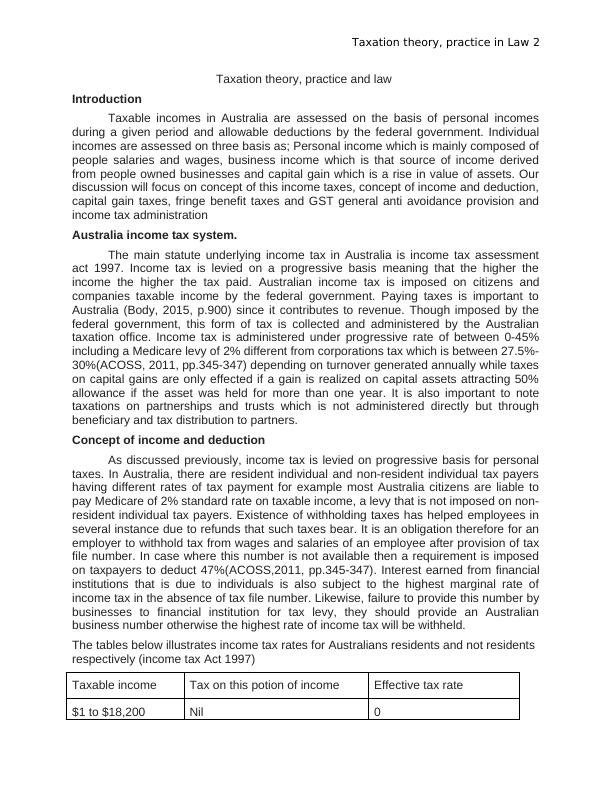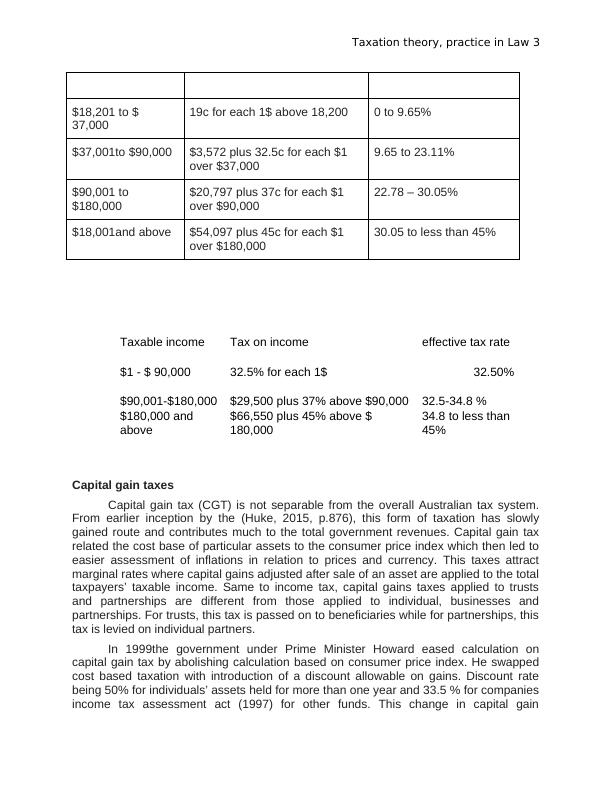Taxation Theory, Practice and Law - Desklib
Added on 2022-11-16
10 Pages3348 Words183 Views
Taxation theory, practice in Law 1
TAXATION THEORY, PRACTICE IN LAW.
Student Name
Professors Name
University
City/State
Date
TAXATION THEORY, PRACTICE IN LAW.
Student Name
Professors Name
University
City/State
Date

Taxation theory, practice in Law 2
Taxation theory, practice and law
Introduction
Taxable incomes in Australia are assessed on the basis of personal incomes
during a given period and allowable deductions by the federal government. Individual
incomes are assessed on three basis as; Personal income which is mainly composed of
people salaries and wages, business income which is that source of income derived
from people owned businesses and capital gain which is a rise in value of assets. Our
discussion will focus on concept of this income taxes, concept of income and deduction,
capital gain taxes, fringe benefit taxes and GST general anti avoidance provision and
income tax administration
Australia income tax system.
The main statute underlying income tax in Australia is income tax assessment
act 1997. Income tax is levied on a progressive basis meaning that the higher the
income the higher the tax paid. Australian income tax is imposed on citizens and
companies taxable income by the federal government. Paying taxes is important to
Australia (Body, 2015, p.900) since it contributes to revenue. Though imposed by the
federal government, this form of tax is collected and administered by the Australian
taxation office. Income tax is administered under progressive rate of between 0-45%
including a Medicare levy of 2% different from corporations tax which is between 27.5%-
30%(ACOSS, 2011, pp.345-347) depending on turnover generated annually while taxes
on capital gains are only effected if a gain is realized on capital assets attracting 50%
allowance if the asset was held for more than one year. It is also important to note
taxations on partnerships and trusts which is not administered directly but through
beneficiary and tax distribution to partners.
Concept of income and deduction
As discussed previously, income tax is levied on progressive basis for personal
taxes. In Australia, there are resident individual and non-resident individual tax payers
having different rates of tax payment for example most Australia citizens are liable to
pay Medicare of 2% standard rate on taxable income, a levy that is not imposed on non-
resident individual tax payers. Existence of withholding taxes has helped employees in
several instance due to refunds that such taxes bear. It is an obligation therefore for an
employer to withhold tax from wages and salaries of an employee after provision of tax
file number. In case where this number is not available then a requirement is imposed
on taxpayers to deduct 47%(ACOSS,2011, pp.345-347). Interest earned from financial
institutions that is due to individuals is also subject to the highest marginal rate of
income tax in the absence of tax file number. Likewise, failure to provide this number by
businesses to financial institution for tax levy, they should provide an Australian
business number otherwise the highest rate of income tax will be withheld.
The tables below illustrates income tax rates for Australians residents and not residents
respectively (income tax Act 1997)
Taxable income Tax on this potion of income Effective tax rate
$1 to $18,200 Nil 0
Taxation theory, practice and law
Introduction
Taxable incomes in Australia are assessed on the basis of personal incomes
during a given period and allowable deductions by the federal government. Individual
incomes are assessed on three basis as; Personal income which is mainly composed of
people salaries and wages, business income which is that source of income derived
from people owned businesses and capital gain which is a rise in value of assets. Our
discussion will focus on concept of this income taxes, concept of income and deduction,
capital gain taxes, fringe benefit taxes and GST general anti avoidance provision and
income tax administration
Australia income tax system.
The main statute underlying income tax in Australia is income tax assessment
act 1997. Income tax is levied on a progressive basis meaning that the higher the
income the higher the tax paid. Australian income tax is imposed on citizens and
companies taxable income by the federal government. Paying taxes is important to
Australia (Body, 2015, p.900) since it contributes to revenue. Though imposed by the
federal government, this form of tax is collected and administered by the Australian
taxation office. Income tax is administered under progressive rate of between 0-45%
including a Medicare levy of 2% different from corporations tax which is between 27.5%-
30%(ACOSS, 2011, pp.345-347) depending on turnover generated annually while taxes
on capital gains are only effected if a gain is realized on capital assets attracting 50%
allowance if the asset was held for more than one year. It is also important to note
taxations on partnerships and trusts which is not administered directly but through
beneficiary and tax distribution to partners.
Concept of income and deduction
As discussed previously, income tax is levied on progressive basis for personal
taxes. In Australia, there are resident individual and non-resident individual tax payers
having different rates of tax payment for example most Australia citizens are liable to
pay Medicare of 2% standard rate on taxable income, a levy that is not imposed on non-
resident individual tax payers. Existence of withholding taxes has helped employees in
several instance due to refunds that such taxes bear. It is an obligation therefore for an
employer to withhold tax from wages and salaries of an employee after provision of tax
file number. In case where this number is not available then a requirement is imposed
on taxpayers to deduct 47%(ACOSS,2011, pp.345-347). Interest earned from financial
institutions that is due to individuals is also subject to the highest marginal rate of
income tax in the absence of tax file number. Likewise, failure to provide this number by
businesses to financial institution for tax levy, they should provide an Australian
business number otherwise the highest rate of income tax will be withheld.
The tables below illustrates income tax rates for Australians residents and not residents
respectively (income tax Act 1997)
Taxable income Tax on this potion of income Effective tax rate
$1 to $18,200 Nil 0

Taxation theory, practice in Law 3
$18,201 to $
37,000
19c for each 1$ above 18,200 0 to 9.65%
$37,001to $90,000 $3,572 plus 32.5c for each $1
over $37,000
9.65 to 23.11%
$90,001 to
$180,000
$20,797 plus 37c for each $1
over $90,000
22.78 – 30.05%
$18,001and above $54,097 plus 45c for each $1
over $180,000
30.05 to less than 45%
Taxable income Tax on income effective tax rate
$1 - $ 90,000 32.5% for each 1$ 32.50%
$90,001-$180,000 $29,500 plus 37% above $90,000 32.5-34.8 %
$180,000 and
above
$66,550 plus 45% above $
180,000
34.8 to less than
45%
Capital gain taxes
Capital gain tax (CGT) is not separable from the overall Australian tax system.
From earlier inception by the (Huke, 2015, p.876), this form of taxation has slowly
gained route and contributes much to the total government revenues. Capital gain tax
related the cost base of particular assets to the consumer price index which then led to
easier assessment of inflations in relation to prices and currency. This taxes attract
marginal rates where capital gains adjusted after sale of an asset are applied to the total
taxpayers’ taxable income. Same to income tax, capital gains taxes applied to trusts
and partnerships are different from those applied to individual, businesses and
partnerships. For trusts, this tax is passed on to beneficiaries while for partnerships, this
tax is levied on individual partners.
In 1999the government under Prime Minister Howard eased calculation on
capital gain tax by abolishing calculation based on consumer price index. He swapped
cost based taxation with introduction of a discount allowable on gains. Discount rate
being 50% for individuals’ assets held for more than one year and 33.5 % for companies
income tax assessment act (1997) for other funds. This change in capital gain
$18,201 to $
37,000
19c for each 1$ above 18,200 0 to 9.65%
$37,001to $90,000 $3,572 plus 32.5c for each $1
over $37,000
9.65 to 23.11%
$90,001 to
$180,000
$20,797 plus 37c for each $1
over $90,000
22.78 – 30.05%
$18,001and above $54,097 plus 45c for each $1
over $180,000
30.05 to less than 45%
Taxable income Tax on income effective tax rate
$1 - $ 90,000 32.5% for each 1$ 32.50%
$90,001-$180,000 $29,500 plus 37% above $90,000 32.5-34.8 %
$180,000 and
above
$66,550 plus 45% above $
180,000
34.8 to less than
45%
Capital gain taxes
Capital gain tax (CGT) is not separable from the overall Australian tax system.
From earlier inception by the (Huke, 2015, p.876), this form of taxation has slowly
gained route and contributes much to the total government revenues. Capital gain tax
related the cost base of particular assets to the consumer price index which then led to
easier assessment of inflations in relation to prices and currency. This taxes attract
marginal rates where capital gains adjusted after sale of an asset are applied to the total
taxpayers’ taxable income. Same to income tax, capital gains taxes applied to trusts
and partnerships are different from those applied to individual, businesses and
partnerships. For trusts, this tax is passed on to beneficiaries while for partnerships, this
tax is levied on individual partners.
In 1999the government under Prime Minister Howard eased calculation on
capital gain tax by abolishing calculation based on consumer price index. He swapped
cost based taxation with introduction of a discount allowable on gains. Discount rate
being 50% for individuals’ assets held for more than one year and 33.5 % for companies
income tax assessment act (1997) for other funds. This change in capital gain

End of preview
Want to access all the pages? Upload your documents or become a member.
Related Documents
Australia Taxation Lawlg...
|12
|2554
|97
Taxation Law: Tax Treatments for Foreigners and Residents Comparedlg...
|7
|1423
|234
Australian Tax Legislationslg...
|13
|2707
|146
Taxation Law: Capital Gains and Deductionslg...
|10
|2626
|21
Australian Tax Law - Income Deduction, FBT, GST, CGT, Anti-Avoidance Provisions and Income Administrationlg...
|13
|2820
|137
Introduction to Income Tax Law - Doclg...
|9
|2263
|35
